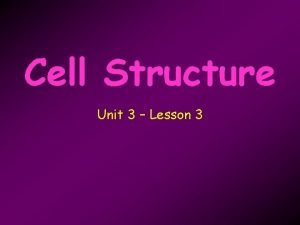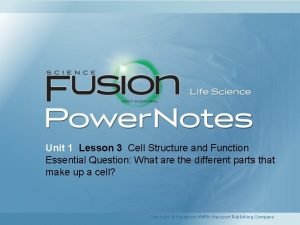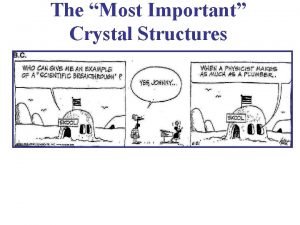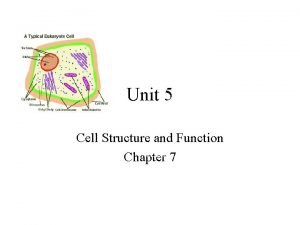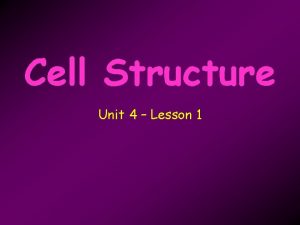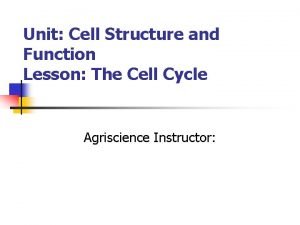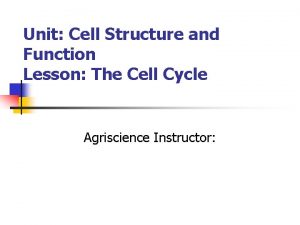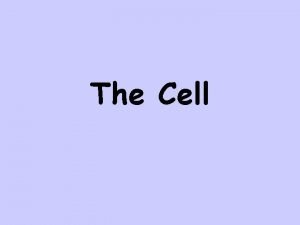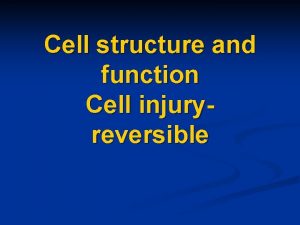Cell Structure Unit 3 Lesson 3 Cell Structure

















- Slides: 17

Cell Structure Unit 3 – Lesson 3

Cell Structure • All parts of the cell are made out of four basic components. – – Proteins Lipids Carbs DNA

Cell Structure • Each cell has a job to do. It needs structures in order to function. • Cells rely on structures called ORGANELLES. Looks like miniorgans!

Cell Structure • Organelles aide the cell with: – Shape and Movement – Manufacturing Molecules – Processing Energy – Processing, Transporting and Storing Molecules

Cell Shape and Movement • Shape is given to the cell by: – Cell Membrane – Cell Wall – Cytoplasm and Cytoskeleton

Cell Membrane • Protective layer around all cells. • It allows food and oxygen into the cell and waste products out of the cell. The pink structure indicates a protein in the cell membrane – proteins allow material in and out of the cell Animal Cell Plant Cell

https: //www. youtube. com/watch? v=LKN 5 sq 5 dt. W 4

Cell Wall • Tough rigid outer coverings that protects the cell and give it shape. • Found in plants, algae, fungi, and some bacteria. Why Do Plant Cells Have Cell Walls? Animal Cell Plant Cell

Cytoplasm • The “soup” in which all other organelles reside. A gelatin like mixture. Animal Cell Plant Cell

Cell Shape and Movement • Movement is given to the cell by: – Cilia – Flagella Animal Cell Plant Cell

Manufacturing Molecules • The cell constantly needs to make molecules for growth and repair. • Organelles that manufacture molecules. – Nucleus – Ribosomes – Endoplasmic Reticulum

The Nucleus • The largest organelle inside eukaryotes • Directs all cellular activities and CONTAINS DNA. • DNA carries the recipe for making proteins, lipids, and carbs (the basic components of all life) Animal Cell Plant Cell

Ribosomes • Structures that make proteins. Amino acids coming together to make PROTEINS

Endoplasmic Reticulum • Allows for production and transport of cellular materials. • Can be smooth or rough – Rough ER has ribosomes!

Processing Energy • All organisms need energy. Organelles that help in energy processing are: – Chloroplasts (plants only) – Mitochondria CHLOROPLAST makes sugar through PHOTOSYNTEHSIS MITOCHONDRIA makes energy from sugar through RESPIRATION

Processing, Transporting, and Storing Molecules • When the cells makes materials for growth and repair, the materials need to be shipped, stored, or processed. Think of UPS. – Golgi Body – like UPS – Vesicles - transport – Vacuoles – storage – Lysosome - digestion PLANT CELLS HAVE BIG VACUOLES!

endoplasmic reticulum nucleus DNA RNA protein on its way! vesicle TO: vesicle ribosomes TO: protein Making Proteins finished protein Golgi apparatus
 How to label hyp opp adj
How to label hyp opp adj Unit 10, unit 10 review tests, unit 10 general test
Unit 10, unit 10 review tests, unit 10 general test Lesson 3 cell structure and function answer key
Lesson 3 cell structure and function answer key Cell
Cell Zns crystal structure unit cell
Zns crystal structure unit cell Unit 5 cell structure and function answer key
Unit 5 cell structure and function answer key Cell city project animal cell
Cell city project animal cell Difference between mercury cell and diaphragm cell
Difference between mercury cell and diaphragm cell Prokaryotic cell vs eukaryotic cell
Prokaryotic cell vs eukaryotic cell Prokaryotic
Prokaryotic Animal vs plant cell venn diagram
Animal vs plant cell venn diagram Spontaneity of redox reactions
Spontaneity of redox reactions Dry cell vs wet cell
Dry cell vs wet cell Plant vs animal cell venn diagram
Plant vs animal cell venn diagram Middle lamella
Middle lamella Vacuole function
Vacuole function Smooth er function
Smooth er function Cell wall vs cell membrane
Cell wall vs cell membrane


